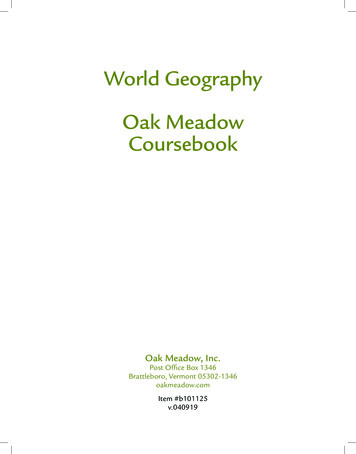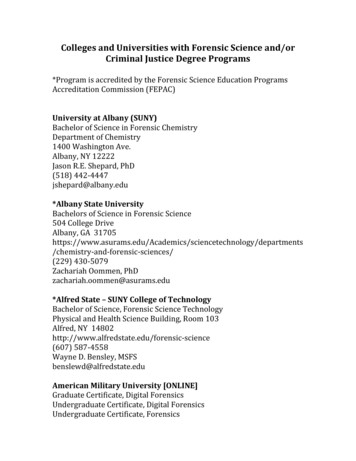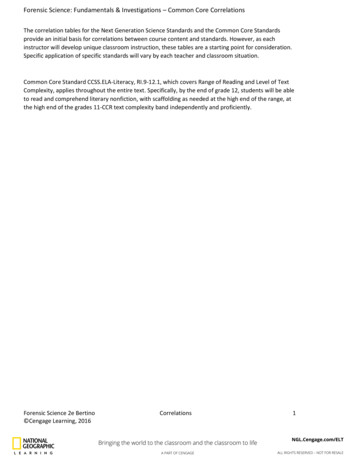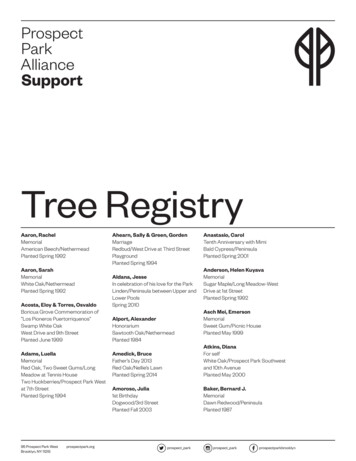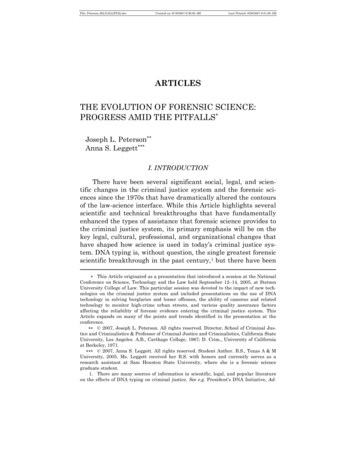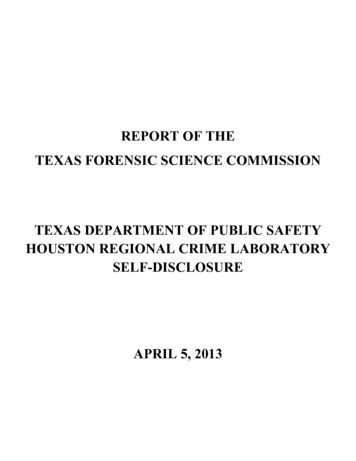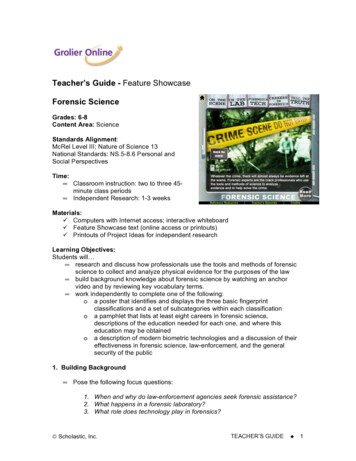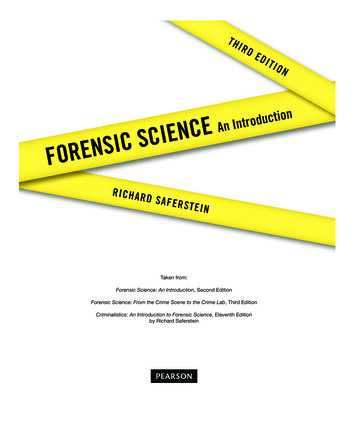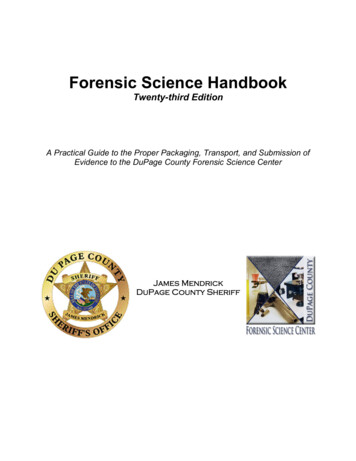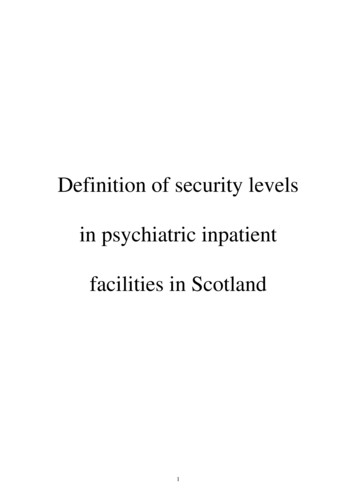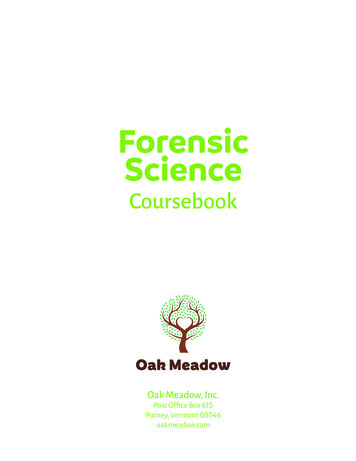
Transcription
ForensicScienceCoursebookOak Meadow, Inc.Post Office Box 615Putney, Vermont 05346oakmeadow.com
Table of ContentsIntroduction.0viiCourse DisclaimerCourse MaterialsLesson 1 Forensic Science and the Law.01Activity A: Locard Exchange PrincipleActivity B: Crime Labs Near YouActivity C: Binge-Worthy True Crime: The CSI EffectLesson 2 Evidence and the Crime Scene.09Activity A: How Accurate Are Eyewitness Accounts?Activity B: Crime Scene Sketching and Evidence CollectionLesson 3 Fingerprints.019Lab 1: Classification of FingerprintsLab 2: Dusting and Lifting FingerprintsLab 3: Latent Detection MethodsLesson 4 Blood and DNA.029Activity A: Blood Pattern AnalysisOption 1: Release HeightOption 2: Angle of ImpactOption 3: The Effect of MovementOption 4: Arterial BloodOption 5: Hand PreferenceActivity B: Who Robbed the Bank? Suspect CODIS AnalysisLab: Extracting DNA from a BananaOak Meadowiii
Table of ContentsForensic ScienceLesson 5 Hair, Fibers, and Glass.043Activity: Virtual MicroscopeLab 1: Fabric and Fiber ObservationLab 2: Observation of Human and Animal HairsLab 3: Analysis of GlassLesson 6 Drugs, Alcohol, Poisons, Arson, and Explosives.055Activity A: The Great Drug DebateActivity B: Calculating Blood Alcohol ConcentrationLab 1: Arson InvestigationLab 2: Explosives and Explosive ResidueLesson 7 Firearms, Toolmarks, Impressions, and Forgery.065Activity A: Shoe Prints in the SnowActivity B: Toolmark ChallengeActivity C: Analyze Your Own HandwritingActivity D: Simulated Forgery (Group Project)Activity E: Gun Control LawsActivity F: Comparing Bite MarksLesson 8 Entomology and Human Remains.073Activity A: Ulna HeightActivity B: The Baked Potato CorpseActivity C: Estimating PMIActivity D: Forensic Anthropology and Modern RefugeesLesson 9 Computer and Mobile Devices.079Activity A: Cyberstalking, Harassing, and Bullying DiscussionActivity B: Satellite ImagingLesson 10 Careers and Final Project.083Activity A: Revisit the CSI EffectActivity B: Careers in Forensic ScienceivOak Meadow
Forensic ScienceTable of ContentsActivity C: Mock Crime SceneActivity D: Infamous Case StudyAppendix.089Lab Materials List. 90Academic Expectations. 93Original Work Guidelines. 94Finding Reputable Sources. 94Plagiarism. 94Citing Your Sources. 95Citing Images. 96Oak Meadowv
IntroductionCourse DisclaimerBeing enrolled in forensic science, it is important that both you and your parent/guardian are aware ofthe topics covered as part of this course. In this course, you will study several controversial topics,which include the following: Crime scene situations and evidenceFingerprint analysisHair and fiber analysisBlood spatter evidenceHandgun and bullet analysisThe effects of a fired bullet on objects and peopleDetection of alcohol and drugs (legal and illegal) associated with a criminal/crime sceneDetection of poisons in bloodImpressions from weapons, footprints, and bite marksHandwriting analysis as it relates to the forgery of documentsArson, explosives, and hazardous materialsDecomposition of a body and forensic entomologyCybercrime and the use of mobile devices by criminals and detectivesCase studies on infamous crimes and serial killersIt is important that you are comfortable with these topics and understand that at several points duringour study of these topics you may encounter graphic images, videos, and illustrations in order to further your understanding of certain topics. It is important to note that to convict criminals, one mustfirst understand the circumstances of criminals, the crimes they commit, and the tools they use tocommit them. This course is not a criminal’s “how-to” guide, but the science behind how criminals arecaught; and they are almost always caught!Oak Meadowvii
IntroductionForensic ScienceShould you or your parent have any questions or concerns regarding the materials being used in thiscourse, please contact your teacher. Make a note in your course doc that you have read this course disclaimer and shared it with your parent/guardian.Course MaterialsThis course will utilize the following items: This coursebook, which includes a full description of all course assignments.The textbook Forensic Science for High School (Kendall Hunt Publishing, 2016), used as the primarysource for lesson information. It is a comprehensive text tailored to high school students and wewill cover almost all the text.Hands-On Laboratory (HOL) Forensic Science Lab Manual and Lab Kit, designed specifically forOak Meadow. The lab kit includes many of the materials needed for the experiments.Additional activity and laboratory materials, as needed. See the appendix for a full list of labmaterials.Scientific calculator, used in select lessons.Smartphone clip-on microscope, 60x zoom, or access to a compound light microscope. If youdon’t have a smartphone or access to a microscope, please discuss other options with yourteacher.Oak Meadow has partnered with Hands-On Laboratories (HOL) to provide you a fully customized laboratory manual and lab kit to accompany this course. These labs are property of HOL and cannot becopied or distributed. Plagiarism of any material (HOL or Oak Meadow) is grounds for dismissal fromthe school.Throughout the course, you will be using articles, videos, and other resources that will enhance yourunderstanding of the material. All of these online resources can be found under the Forensic Sciencetab at https://www.oakmeadow.com/curriculum-links/. You can bookmark this webpage for easyreference.Important note: You will notice that this coursebook does not include images. This is by design to takeinto account students who may be sensitive to such material. Use discretion if looking up case studiesonline. There is an abundance of highly graphic images online that in many cases do not serve any purpose in understanding how the crime scene was processed or how the evidence was analyzed. Highlygraphic images may desensitize you and are not in keeping with Oak Meadow’s educational philosophy. You are encouraged to focus on the information in the lessons and textbook and only seek additional images or information when directed to do so.viiiOak Meadow
Lesson1Forensic Scienceand the LawLearning ObjectivesAt the end of this lesson you will be able to: Describe the basic types of law in the criminal justice system.Explain the major differences between the Frye standard andDaubert ruling.Recognize that technological problems often create a demandfor new scientific knowledge.Explain the Locard Exchange Principle.Study how crime labs in the United States are organized andwhat services they provide.“In the criminal justice system, the peopleare represented by two separate yet equallyimportant groups: the police who investigatecrime and the district attorneys whoprosecute the offenders.”Dun Dun.ASSIGNMENT SUMMARY Review laboratory safetyprocedures. Review course disclaimer. Answer Before You Beginquestions. Read chapter 1 in thetextbook. Read three case studies. Complete lessonassignments. Activity A: LocardExchange Principle Complete either ActivityB or C. Activity B: Crime LabsNear You Activity C: Binge-WorthyTrue Crime: The CSI EffectSound familiar? Chances are you have watched at least one crimeshow or movie. Perhaps your love for Law & Order, CSI, or a similarshow is what led you to take this course. Most people seem to havean interest in the criminal system and how science is used to bringjustice for the victims. The goal of this course is to take that natural curiosity and delve into each majortype of forensic evidence to explore exactly how that evidence is analyzed and used in court. But first,let’s take a look at the history of forensic science and the law.This lesson will take about two weeks to complete.Oak Meadow1
Lesson 1: Forensic Science and the LawForensic ScienceReview of Laboratory SafetyThroughout the course, you will conduct home experiments that involve the use of potentially harmfulchemicals. For example, in lesson 3, you will conduct a series of labs that use highly toxic chemicals forthe chemical development of latent fingerprints. These labs are designed to give you a hands-on learning experience, but they need to be done in a safe manner. As such, it is important that we begin thiscourse with a review of safe laboratory techniques.1. Wear closed-toe shoes when working with chemicals.2. Keep all other nonessential items, such as bags, papers, food, cosmetics, lotions, etc., out of thework space.3. Never eat, drink, or chew gum when working on labs.4. Before every lab, read the directions carefully before beginning. Make sure you understand theoverall goal of the lab before you start the procedure.5. Check all equipment and supplies to ensure they are clean and in working order beforebeginning.6. Gather all equipment needed for the lab. Keep all other lab materials packaged and out of thework space.7. Always wear safety goggles and gloves. They are provided in your lab kit.8. Tie back long hair and loose clothing to keep them away from chemicals and flames.9. Remove dangling jewelry.10. Never touch, taste, or smell any chemical. To note odor, gently wave your hand over the openingof the container to direct the fumes toward your nose and smell carefully (wafting).11. Never conduct your own experiments. Follow the directions provided and use materials for theirintended use.12. Hot glassware does not appear hot. Carefully check the temperature before touching.13. Dispose of any unused or spilled chemicals by soaking them up with a paper towel and placing itin a trash can. Never dispose of chemicals down the sink or toilet.14. Clean up your work space and all equipment after the experiment. Dispose of materials asnoted above or place them back in your lab kit for future use. Since you are conducting theseexperiments at home, and presumably in your kitchen, it is critically important that you clean upyour work space before anyone else uses the area or food is prepared.15. Wash your hands after each experiment!Enrolled students: Make note in your course doc that you have read these rules and understand them.If at any point during this course, you have questions on the laboratory directions or need assistance,you are urged to stop work and contact your teacher immediately.2Oak Meadow
Forensic ScienceLesson 1: Forensic Science and the LawBefore You BeginConsider the following scenario:A man took a slug of what he thought was Jack Daniel’s whiskey. He suffered extreme oral andesophageal burns. It was thought that the Jack Daniel’s bottle contained not whiskey, but sulfuric acid. The lawyer representing the plaintiff (the man who drank the stuff) contacted a forensic scientist to analyze the contents. A chemical spot test and simple titration of the dilutedproduct confirmed that it was, indeed, sulfuric acid, at a concentration of approximately83 percent.Manufactured strength of sulfuric acid is commonly 98 percent or 93 percent, which in bothcases is termed “concentrated.” The former is what chemists use; the latter is sold in stores asdrain cleaner. The next common industrial grade is 70 percent. So a concentration of 83 percent was perplexing. (Battery acid is usually about 33 percent.) The forensic scientist surmisedthat the product in the liquor bottle was used drain cleaner; this would account for the dilutionas well as the light brown color (similar to that of true whiskey), which probably resulted fromdissolved metals. A cursory spot test indicated the presence of metals in the acid.Someone had probably used the drain cleaner, decided to save it, and so poured it into a handyreceptacle, but did not label it.Answer the following questions and explain your reasoning:1. Was a crime committed?2. If so, who would be at fault?(Source: Ball, Barbara. Forensic Science for High School, 1st edition)ReadingRead chapter 1 (pages 4–35) in your textbook.Case StudiesIn each lesson of this course, case studies are used to help provide more insight to the topic beingdiscussed. Sometimes these case studies are major cases or serial killers, other times they are little- known cases that still serve as a key example of the type of evidence being studied. Occasionally, thesecases are extremely complex and involve several types of major evidence; several of these cases will berevisited in subsequent lessons.Oak Meadow3
Lesson 1: Forensic Science and the LawForensic Science1. Richard CraftsRead the case study on pages 30–31.2. Casey Anthony and the Frye HearingsIn a widely publicized trial, Casey Anthony was charged with first-degree murder of her two-year-olddaughter, Caylee Anthony, in Orlando, Florida. The case gained media attention in part from Casey’smother, Cindy Anthony, reporting her granddaughter missing in a 911 call stating Caylee had not beenseen for over a month and her daughter’s car smelled like a dead body had been inside it.Caylee’s body was found five months later in a trash bag in the woods near the Anthony home. Thetrial began in 2011 with the prosecution arguing that Casey murdered her daughter because she nolonger wanted to be a parent. Casey was caught in several lies to detectives and there was evidencethat she enjoyed partying. The defense presented a story that Caylee drowned in the family pool andthat Casey’s father, George, disposed of Caylee’s body.The case hinged on the scientific credibility of the evidence presented at trial and went through weeksof Frye hearings before the judge. During these hearings, the evidence was critiqued to determine if itwas “generally accepted” by the scientific community. The critical piece of evidence in question was anew technique used for analyzing the presence of a decaying corpse in Casey Anthony’s trunk. The testresults showed decomposition from a human body; however, this test had never been used in courtbefore this trial and there were no peer-reviewed studies conducted. The judge ruled the evidence wasallowed at trial based on other circumstantial evidence and computer searches on Casey’s computer.On July 5, 2011, the jury found Casey Anthony not guilty of first-degree murder. Following the trial,jurors stated that their critique of the scientific validity of the evidence is what resulted in them finding Casey not guilty.(Source: “Casey Anthony Trial,” crimemuseum.org)3. The Murder of Danielle van DamOn February 2, 2002, seven-year-old Danielle van Dam was reported missing by her parents. Her bodywas discovered on February 27th partially decomposed, unclothed, and there were several teeth missing, likely from some trauma to her face.Neighbor David Westerfield was immediately identified as a suspect as he had gone camping in his RVduring the time in question and when asked if he had any information about the girl’s disappearance,Westerfield responded that she must have been kidnapped and murdered. Among the pieces of evidence used against David Westerfield were: 4Hairs consistent with the van Dams’ dog found in Westerfield’s RVCarpet fibers consistent with Danielle’s bedroom found in his RV14 hairs consistent with Danielle’s found in his belongings in the RVOak Meadow
Forensic Science Lesson 1: Forensic Science and the LawLack of fibers found in his home, suggesting that fibers found in the RV may have come fromsomeone going directly from her house to his RVLack of evidence (sand, soil, and vegetation from the dump site was not found on his shoes, laundry, shovel, or RV) suggesting he disposed of evidence and went on a cleaning frenzyWesterfield was convicted of kidnapping and first-degree murder. He was sentenced to death in 2003and is currently serving his sentence in California. However, the state of California ruled the death penalty unconstitutional in 2014, so it is presumed he will not face execution. This case is an example ofthe most fundamental forensics principle, the Locard Exchange Principle, bringing justice to amurderer.(Source: “DNA expert: Blood on Westerfield’s jacket matches slain girl’s,” cnn.com)Assignments1. Answer the following questions about the Richard Crafts case study.a. What would have been considered hearsay evidence at Crafts’s trial?b. Why is hearsay inadmissible in court? During what type of case is hearsay allowed?2. Answer the following questions about the Casey Anthony case study.a. What is the importance of establishing evidence according to the Frye standard and Daubertruling? What is the difference between the two?b. Is it the judge or the jury who should decide what evidence is admissible at trial?c. Does the result of Casey Anthony’s trial mean that she is innocent? Explain.3. Why is it important that a forensic scientist’s results be scientifically and legally sound?4. Explain how the steps of the scientific method apply to an investigation.5. Using the time line of forensic science (pages 8–17), select any three scientific discoveries anddiscuss how they overlap with other courses you may have taken.6. It is very common in TV shows for the suspect to be read his rights when arrested. In reality,though, the reading of the Miranda rights may not happen as often as we are led to believe.When does an officer not have to read Miranda rights to an arrested person?7. In a few short sentences, describe what typically happens to a suspect after a person is arrestedand charged with a crime (from being identified as a suspect to the trial date).8. Why would a suspect enter a plea of nolo contendere?9. What must a defendant prove to be found not guilty by reason of insanity?Oak Meadow5
Lesson 1: Forensic Science and the LawForensic Science10. Revisit your answers to the Before You Begin section above.a. Was a crime committed? Explain your reasoning.b. Who was at fault, the man who took a drink or the person who did not label what was in thebottle?c. Suppose the victim died of his injuries. Does this change your opinion? If this is to be viewed asa crime, what category of crime does this fall under and what are the charges?Activity ChoicesComplete Activity A and then choose between Activity B or C. Activity A: Locard Exchange PrincipalActivity B: Crime Labs Near YouActivity C: Binge-Worthy True Crime: The CSI EffectActivity A: Locard Exchange PrincipalThe Locard Exchange Principal states that every time you make contact with a person or object there isan exchange of materials. This exchange is what forensic scientists use to collect trace evidence andpossibly track a person’s daily movements.Let’s take a closer look at your schedule and how the Locard Exchange Principal could be applied towhat you did today.Before you begin1. Make a list of all activities you did since waking up today until this very moment.2. As you went through each of the above activities, what did you come in contact with?3. Did you leave any evidence of where you were?4. Were you observed by others who would be able to provide eyewitness accounts of youractivities?5. Now, focus on the present. As you sit right now, what are you in contact with? What possibletransfer of material could have taken or is taking place? Make a list.6. How could you have prevented any transfer if you had thought about it first? What transferredmaterials could be traced to you directly?7. Is it difficult not to leave a trace? Do you think premeditated contact can diminish identifiabletransfers? Give some hypothetical examples where destroying evidence might leave more thatcould identify you. Compile your responses for this activity into a two-paragraph response.6Oak Meadow
Forensic ScienceLesson 1: Forensic Science and the LawActivity B: Crime Labs Near YouWhen a crime has been committed in your town, where does the evidence from the crime scene go tobe analyzed? Start by googling your state (or country if you are outside the U.S.) to find out where thepublicly operated state crime labs are located. How many labs are there within your state? What services do they provide? Create a map showing their location and the types of evidence handled at eachlocation.Activity C: Binge-Worthy True Crime: The CSI EffectChances are you are taking this course because you have been impacted by what is called the “CSIEffect” (pages 28–30). We are going to put your ability to understand Hollywood’s depiction of a crimeversus real forensic science to the test. For this activity, select a podcast series or documentary/truecrime series. You will listen/watch the complete series this week. Note that you should check the ratingand obtain parental permission prior to viewing. Below are some suggested series:Podcasts: Dr. DeathDirty JohnOver My Dead BodySerialNetflix series: The StaircaseAmanda KnoxEvil GeniusMaking a MurdererThe Innocent ManThere are many others. If you select another, it should focus on just one crime, not a different crime ineach episode. Notify your teacher which series you select before beginning.As you watch/listen, complete the following:1. Take detailed notes on the elements of the crime and crime scene, victim(s), suspect(s),investigation details, and the trial(s). Include these notes in your course doc for this lesson.Consider organizing your notes into a table or chronological list of details.2. Provide your opinion on this case. Do you think the evidence supports the results of the trial?Oak Meadow7
Lesson 1: Forensic Science and the LawForensic Science3. What is the current status of this case? You will revisit the case at the end of this course, so makesure your notes are detailed enough that you will not have to relisten/watch at the end of thecourse.Further Study(This is an optional activity.)There are many great books related to forensic science that will not only make your understanding of this course deeper, but are page turners too! Here are some great options, if youare interested: Stiff: The Curious Lives of Human Cadavers by Mary RoachDeath’s Acre: Inside the Legendary Forensic Lab, the Body Farm, Where the Dead Do Tell Tales byWilliam Bass and Jon JeffersonSilent Witnesses: The Often Gruesome but Always Fascinating History of Forensic Science byNigel McCreryThere any many more. Let your teacher know what you have read or are currently readingthat relates to forensic science.FOR ENROLLED STUDENTSWhen you have completed this lesson, submit the following work to your Oak Meadow teacher: 8Acknowledgment of lab safety rulesAcknowledgment of the course disclaimerAnswers to Before You Begin questionsAssignment responsesActivity A: Locard Exchange PrincipleChoice of Activity B (Crime Labs Near You) or Activity C (Binge-Worthy True Crime: The CSI Effect)Optional extra credit: Further StudyOak Meadow
Lesson2Evidence and theCrime SceneLearning ObjectivesAt the end of this lesson you will be able to: Explain the difference between indirect and direct evidence.Describe what is meant by physical evidence and give examples.Describe the difference between individual and class evidence.Create a final crime scene sketch and identify potential evidence.“I always go in with an open mind . . . I don’t even believe what the police tellme . . . I let the evidence speak for itself.”Dr. Henry C. Lee (a leading forensic scientist who has gainedASSIGNMENT SUMMARY Read chapters 2 and 3 inthe textbook. Read five case studies andanswer questions. Complete lessonassignments. Activity A: How AccurateAre Eyewitness Accounts? Activity B: Crime SceneSketching and EvidenceCollectionfame working on high profile and cold cases)In this lesson, you will gain an understanding of how crime scenes are secured as well as the types ofevidence investigators look for when processing a crime scene and working an investigation. It oftentakes several iterations of testing and analysis for a crime to be fully processed and for investigators tounderstand what occurred. Information and samples collected take teams of scientists many monthsor years to analyze and test, depending on the nature of the crime.Crimes can go unsolved due to lack of sufficient evidence. Innocent people can be convicted on inaccurate evidence. Juries can be swayed based on how evidence is presented in court. Likewise, heinouscrimes can be solved, and criminals caught, on just one piece of crucial physical evidence, if preservedand analyzed correctly. It all starts at the crime scene. Let’s take a closer look at how important evidence is to solving a crime.You have two weeks to complete this lesson.Oak Meadow9
Lesson 2: Evidence and the Crime SceneForensic ScienceReadingRead chapter 2 (pages 38–53) in your textbook.Read chapter 3 (pages 60–72) in your textbook.Case Studies1. Ronald CottonRonald Cotton was wrongfully accused and convicted of a crime he did not commit, based partially onan eyewitness account that later proved to be inaccurate.In July 1984, an assailant broke into two apartments on separate occasions in Burlington, NorthCarolina. He cut phone wires, attacked and raped the women living there, searched through theirbelongings, and stole money. After photo identification by one of the victims, Ronald Cotton wasarrested for the crimes. The prosecutor’s evidence consisted of the following: Testimony by the other victim after seeing a lineupA flashlight found in Cotton’s home that resembled one the assailant usedRubber from Cotton’s tennis shoe that was found to be consistent with rubber found at the crimesceneThe photo ID from the victimIt was not disclosed at the trial, but the second victim had picked out another man from the lineup.Cotton’s attorney filed an appeal based on this information. At the second trial, the second victim haddecided that Cotton was indeed the assailant. Also during the second trial, a prison inmate, BobbyPoole, confessed to fellow inmates that he was the one who had committed the crimes. The judgerefused to have this information submitted into evidence.At the conclusion of the second trial in November 1987, Cotton was convicted of both rapes and sentenced to life plus 54 years in prison.Cotton continued to claim that he was innocent and repeatedly asked for appeals. In 1994, Cotton gottwo new lawyers who filed a motion for DNA testing. The evidence sample from one of the victims wastoo degraded and did not give any information, but samples from the other were intact enough to betested. The sample did not match Cotton, and so he was ruled out as the perpetrator. At the request ofthe defense, the DNA was submitted to the North Carolina convicted violent felon database; itmatched that of the inmate Bobby Poole.Cotton was released in 1995 after spending almost 11 years in prison for a crime he did not commit. Hewas officially cleared of all charges and offered 5,000 as compensation.(Source: innocenceproject.org)10Oak Meadow
Forensic ScienceLesson 2: Evidence and the Crime Scene2. Jeffrey MacDonaldRead the case study on pages 67–68.3. Amanda KnoxRead the case study on pages 68–71. Answer questions 1 and 2 on page 71.4. O. J. SimpsonOrenthal James Simpson (“O. J.”) was an accomplished football player, sports commentator, and actorwell known in the 1990s. On June 12, 1994, O. J.’s ex-wife Nicole Brown and her friend Ronald Goldmanwere found murdered outside Brown’s condo in Los Angeles. Nicole Brown had been brutally stabbedin the head and neck with defense wounds on her arms. Reconstruction of the crime scene indicatedthat Goldman likely arrived sometime during or shortly after Brown was murdered and was alsostabbed to death.O. J. Simpson was identified as a suspect and asked to turn himself in to the Los Angles PoliceDepartment, which led to a high-profile chase in June 1994 of Simpson in his white Ford Bronco.Simpson pleaded not guilty to both murders and a highly publicized trial began in January 1995.Key evidence in this case included the following: DNA from Simpson, Brown, and Goldman found on a glove at the crime scene and in Simpson’sFord BroncoA match to the glove at the crime scene found behind the guest house on Simpson’s propertyA bloody sock at Simpson’s house contained Brown’s blood (discredited by Dr. Henry Lee, medicalexpert for the defense who argued contamination during collection of evidence)Blond hairs were found on Simpson’s glove; African American hairs were found on Goldman’s shirtBloody footprints at the crime scene matched Simpson’s shoe size and were a match to a rare,expensive type of shoe; it was never proven that Simpson owne
The textbook Forensic Science for High School (Kendall Hunt Publishing, 2016 ), used as the primary source for lesson information. It is a comprehensive text tailored to high school students and we will cover almost all the text. Hands-On Laboratory (HOL) Forensic Science Lab

